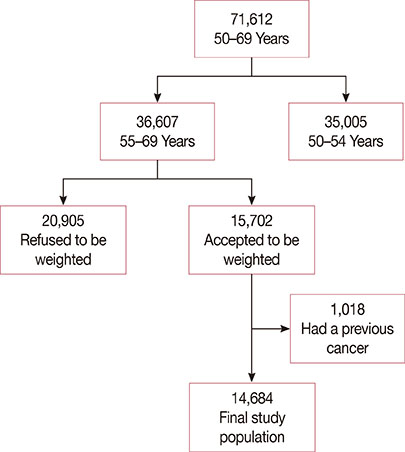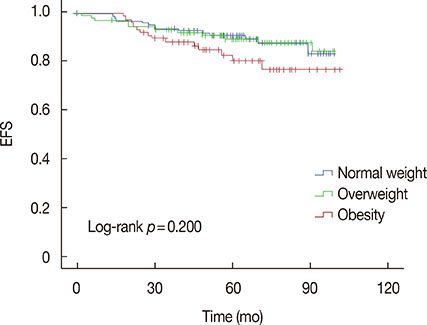J Breast Cancer.
2016 Sep;19(3):283-291. 10.4048/jbc.2016.19.3.283.
Increased Incidence of Breast Cancer in Postmenopausal Women with High Body Mass Index at the Modena Screening Program
- Affiliations
-
- 1Department of Diagnostic and Clinical Medicine and Public Health, University of Modena and Reggio Emilia, Modena, Italy.
- 2Department of Oncology, Hematology, and Respiratory Diseases, University of Modena and Reggio Emilia, Modena, Italy. cortesi.laura@policlinico.mo.it
- 3Department of Preventive and Predictive Medicine, National Tumor Institute, Milan, Italy.
- 4Department of Radiology, University of Modena and Reggio Emilia, Modena, Italy.
- KMID: 2413953
- DOI: http://doi.org/10.4048/jbc.2016.19.3.283
Abstract
- PURPOSE
We conducted a study to evaluate the relationship between body mass index (BMI) and the risk of breast cancer (BC) and outcome in a population of 14,684 women aged 55 to 69 years eligible to participate in the Mammography Screening Program (MSP) in the Province of Modena, Italy.
METHODS
The study population was drawn from women who underwent mammography screening between 2004 and 2006 in the Province of Modena. Women were subdivided into obese, overweight, and normal-weight categories according to BMI and followed until July 31, 2010, to evaluate the BC incidence. The clinicopathological characteristics of BC were also evaluated in different groups of patients classified according to BMI. After BC diagnosis, patients were followed for a median period of 65 (range, 2-104) months. Second events (recurrences and second tumors) were recorded, and the 5-year event-free survival (EFS) was calculated.
RESULTS
After a period of 73 months, 366 cases of BC were diagnosed. Compared with normal-weight women, obese women had a significantly higher incidence of BC (relative risk [RR], 1.32; p=0.040) (RR=1), larger tumors (27% of tumors were larger than T2 size), and more nodal involvement (38.5% of tumors were node-positive). Furthermore, a significantly higher rate of total events was seen in obese women compared with overweight and normal-weight patients, respectively (17.9% vs. 11.4% vs. 10.8%, p=0.032). The 5-year EFS was 89.0%, 89.0%, and 80.0% for normal-weight, overweight, and obese patients, respectively.
CONCLUSION
We observed a significantly higher risk of BC in obese women among those eligible to participate in the MSP in the Province of Modena. Finally, obese women had more second events and poorer EFS compared to nono bese women.
MeSH Terms
Figure
Reference
-
1. Eliassen AH, Colditz GA, Rosner B, Willett WC, Hankinson SE. Adult weight change and risk of postmenopausal breast cancer. JAMA. 2006; 296:193–201.
Article2. Montazeri A, Sadighi J, Farzadi F, Maftoon F, Vahdaninia M, Ansari M, et al. Weight, height, body mass index and risk of breast cancer in postmenopausal women: a case-control study. BMC Cancer. 2008; 8:278.
Article3. Feigelson HS, Jonas CR, Teras LR, Thun MJ, Calle EE. Weight gain, body mass index, hormone replacement therapy, and postmenopausal breast cancer in a large prospective study. Cancer Epidemiol Biomarkers Prev. 2004; 13:220–224.
Article4. Connolly BS, Barnett C, Vogt KN, Li T, Stone J, Boyd NF. A meta-analysis of published literature on waist-to-hip ratio and risk of breast cancer. Nutr Cancer. 2002; 44:127–138.
Article5. Sonnenschein E, Toniolo P, Terry MB, Bruning PF, Kato I, Koenig KL, et al. Body fat distribution and obesity in pre- and post-menopausal breast cancer. Int J Epidemiol. 1999; 28:1026–1031.
Article6. Peacock SL, White E, Daling JR, Voigt LF, Malone KE. Relation between obesity and breast cancer in young women. Am J Epidemiol. 1999; 149:339–346.
Article7. Weiderpass E, Braaten T, Magnusson C, Kumle M, Vainio H, Lund E, et al. A prospective study of body size in different periods of life and risk of premenopausal breast cancer. Cancer Epidemiol Biomarkers Prev. 2004; 13:1121–1127.8. Carmichael AR. Obesity as a risk factor for development and poor prognosis of breast cancer. BJOG. 2006; 113:1160–1166.
Article9. Chlebowski RT, Aiello E, McTiernan A. Weight loss in breast cancer patient management. J Clin Oncol. 2002; 20:1128–1143.
Article10. Dal Maso L, Zucchetto A, Talamini R, Serraino D, Stocco CF, Vercelli M, et al. Effect of obesity and other lifestyle factors on mortality in women with breast cancer. Int J Cancer. 2008; 123:2188–2194.
Article11. Protani M, Coory M, Martin JH. Effect of obesity on survival of women with breast cancer: systematic review and meta-analysis. Breast Cancer Res Treat. 2010; 123:627–635.
Article12. Petrelli JM, Calle EE, Rodriguez C, Thun MJ. Body mass index, height, and postmenopausal breast cancer mortality in a prospective cohort of US women. Cancer Causes Control. 2002; 13:325–332.13. Sieri S, Pala V, Brighenti F, Pellegrini N, Muti P, Micheli A, et al. Dietary glycemic index, glycemic load, and the risk of breast cancer in an Italian prospective cohort study. Am J Clin Nutr. 2007; 86:1160–1166.
Article14. Reeves GK, Pirie K, Beral V, Green J, Spencer E, Bull D, et al. Cancer incidence and mortality in relation to body mass index in the Million Women Study: cohort study. BMJ. 2007; 335:1134.
Article15. Report of a WHO consultation. Obesity: preventing and managing the global epidemic. World Health Organ Tech Rep Ser. 2000; 894:i–xii. 1–253.16. Baldissera S, d'Argenio P, Ferrante G, Minardi V, Possenti V, Quarchioni E, et al. Overweight: one adult out of 10 is obese, 1 out of 3 is overweight. Epidemiol Prev. 2011; 35:5-6 Suppl 2. 81.17. Sobin LH, Gospodarowicz MK, Wittekind C. International Union against Cancer. TNM Classification of Malignant Tumours. 7th ed. New York: Wiley;2009.18. Harvie M, Hooper L, Howell AH. Central obesity and breast cancer risk: a systematic review. Obes Rev. 2003; 4:157–173.
Article19. Key TJ, Appleby PN, Reeves GK, Roddam A, Dorgan JF, Longcope C, et al. Body mass index, serum sex hormones, and breast cancer risk in postmenopausal women. J Natl Cancer Inst. 2003; 95:1218–1226.
Article20. Cui Y, Whiteman MK, Flaws JA, Langenberg P, Tkaczuk KH, Bush TL. Body mass and stage of breast cancer at diagnosis. Int J Cancer. 2002; 98:279–283.
Article21. Hall HI, Coates RJ, Uhler RJ, Brinton LA, Gammon MD, Brogan D, et al. Stage of breast cancer in relation to body mass index and bra cup size. Int J Cancer. 1999; 82:23–27.
Article22. Madeddu C, Gramignano G, Floris C, Murenu G, Sollai G, Macciò A. Role of inflammation and oxidative stress in post-menopausal oestrogen-dependent breast cancer. J Cell Mol Med. 2014; 18:2519–2529.
Article23. Feigelson HS, Patel AV, Teras LR, Gansler T, Thun MJ, Calle EE. Adult weight gain and histopathologic characteristics of breast cancer among postmenopausal women. Cancer. 2006; 107:12–21.
Article24. Vrieling A, Buck K, Kaaks R, Chang-Claude J. Adult weight gain in relation to breast cancer risk by estrogen and progesterone receptor status: a meta-analysis. Breast Cancer Res Treat. 2010; 123:641–649.
Article25. Suzuki R, Orsini N, Saji S, Key TJ, Wolk A. Body weight and incidence of breast cancer defined by estrogen and progesterone receptor status: a meta-analysis. Int J Cancer. 2009; 124:698–712.
Article26. Cortesi L, De Matteis E, Rashid I, Cirilli C, Proietto M, Rivasi F, et al. Distribution of second primary malignancies suggests a bidirectional effect between breast and endometrial cancer: a population-based study. Int J Gynecol Cancer. 2009; 19:1358–1363.
Article27. Levi F, Te VC, Randimbison L, La Vecchia C. Cancer risk in women with previous breast cancer. Ann Oncol. 2003; 14:71–73.
Article28. Palacios S, Henderson VW, Siseles N, Tan D, Villaseca P. Age of menopause and impact of climacteric symptoms by geographical region. Climacteric. 2010; 13:419–428.
Article29. Niedhammer I, Bugel I, Bonenfant S, Goldberg M, Leclerc A. Validity of self-reported weight and height in the French GAZEL cohort. Int J Obes Relat Metab Disord. 2000; 24:1111–1118.
Article30. Stevens J, Keil JE, Waid LR, Gazes PC. Accuracy of current, 4-year, and 28-year self-reported body weight in an elderly population. Am J Epidemiol. 1990; 132:1156–1163.
Article
- Full Text Links
- Actions
-
Cited
- CITED
-
- Close
- Share
- Similar articles
-
- Breast Cancer Screening with MRI
- Benefits and Harms of Breast Screening: Focused on Updated Korean Guideline for Breast Cancer Screening
- Risk Factors and Control Strategies for the Rapidly Rising Rate of Breast Cancer in Korea
- Early screening for breast cancer
- Estimating Relative Risk of Breast Cancer in Korean Women Using Computer Program



